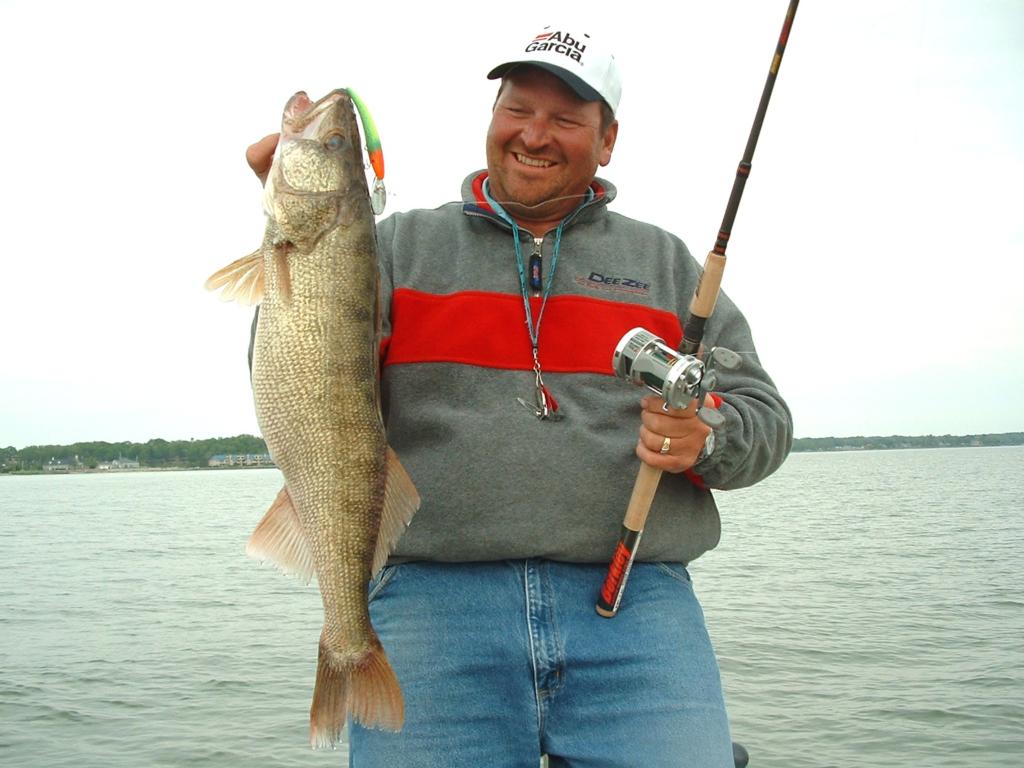Troll, troll, troll your boat

RCL Walleye Tour field on Lake Erie will be on move as much as fish
PORT CLINTON, Ohio – In anticipation of the Wal-Mart RCL Walleye Tour’s May 28-31 event on Lake Erie it appears that a mastery of subtleties will be essential. With an open-water troll-a-thon in the offing, refinements in speeds, the decision of spinners vs. crankbaits and the corresponding response to an armada of boats on key locations should tell in the tale of the scales.
Numbers of walleyes haven’t exactly been in shortage during the practice period. The sizable ones pushing upward of 7 pounds, however, certainly have been scarce – a key difference from springtime, when the competitors have had most of their experience here.
“The challenge is to find consistently bigger fish,” says Lund pro Andy Kuffer of Fair Haven, Mich. “The bigger ones are scattered now. A majority of them have migrated out to the middle of the lake.”
Indeed, Erie’s walleyes are notorious roamers, splitting the scene of spawning reefs in the lake’s Western Basin in April and beginning a counterclockwise circumnavigation of the inland sea. Further confounding – and diminishing – the prospects of 40- to 50-pound five-fish bags are fewer fish in the system, down from an estimated 90 million in the early ’90s to less than half that today.
In addition, a strong year-class from the ’99 spawn, after poor spawns attributable to high spring winds and cold weather for at least two years prior, has yielded far more 4-pounders than 9s and 10s.
“It looks like there’s fewer fish than in years past,” Kuffer says. “I think it’s going to take 30 pounds a day to make the cut.”
It’s not April anymore
In other words, forget the epic bags that have been weighed here in tournaments past, including the April 2001 RCL event won by Jim Klick of White Bear Lake, Minn., with 40 pounds, 12 ounces on the final day. One probability, if any, will be a glut of weights in the 20-pound range.
Which demands an attitude adjustment from times when 8-pounders were run-of-the-mill occurrences and the fish are seriously on the move.
“I think it’s going to be a numbers game in traditional big-fish areas,” says Lund pro Mike Gofron of Antioch, Ill. “It’s totally different from the spring. You have to figure that’s when they’re totally concentrated. Now they have hundreds of miles and breaklines to disperse.”
If the walleyes are less predictable and more spread out, the great expectations of a month earlier call for serious re-evaluation.
“Everyone’s looking for a little bit bigger fish than they’re going to find,” says Ranger pro Mark Brumbaugh of Arcanum, Ohio. “You have a lot bigger fish at the first of April. They’re scattered a lot more, and there are not as many as there used to be. So when they go to open water, they’re not as easy to stay on top of.”
Lost in the crowd?
Staying on top of the schools of walleyes in the expected playing field – from the Bass Islands north to Canadian waters and east to Lorain, Ohio, all within runnable distances since the RCL sets no boundaries on enormous Erie – will call for not only a variety of trolling techniques but also painstaking attention to detail and the wherewithal to adjust on the fly when schools get hit hard by a pack of boats.
While trolling long, slim crankbaits behind planer boards is April’s go-to method, another month on the calendar and water temperatures in the low 60s will undoubtedly open the door for several other methods in walleyedom. Among them are spoons behind Jet Divers, a diving plane, and Dipsy Divers, circular diving planes that will veer off left or right away from the boat, and spinner rigs behind boards or with bottom bouncers ticking the lake floor.
Both spoons and spinners start to take off when water temperatures warm to at least 50 degrees, even more so when they reach the 60s. Another factor of note is the fishes’ increased inclination to following contours and breaklines, rather than roving after baitfish in the middle of nowhere.
Why the Erie walleyes seem to be changing their M.O. is a matter of conjecture, at best. Could the reason be fewer baitfish? Perhaps. Could it be clearer water in the era of particle-straining zebra mussels? Maybe. Could it be something else? Absolutely.
No matter the explanation for the walleyes’ changing ways, the competitors will have to adjust with them and with concentrations of their peers on key fish-holding areas. Expect dozens of boats, perhaps 100 of them, trolling over the same fish throughout the day, pushing the walleyes out to the sides or down to the bottom.
One thing is for certain: The pros who make the necessary adjustments under pressure and in the face of itinerant walleyes with the onset of summer are undoubtedly going to have the biggest bags on ever-changing Erie – even if that means 40-pound weights are in short supply. Oh, the difference a month makes.
Wednesday’s takeoff starts at 7 a.m. at Catawba Island State Park.